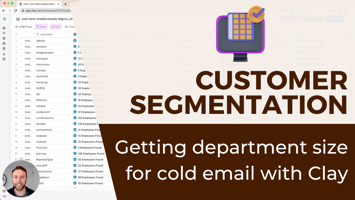We’re so excited for the upcoming months here at Intro CRM. We want to take some time to give you a...
Sales prospecting with firmographic data
Let’s explore a topic you are likely familiar with but didn’t know what it’s called. If you are sales prospecting and want to segment a list of companies based on revenue or growth, or find new leads based on their industry or headcount, then read on.
These traits are called firmographics. Firmographics are descriptive attributes or characteristics we can use to help categorize organizations—typically businesses, but they can also be applied to government agencies and educational institutions too.
What are firmographics?
Firmographics are used in business-to-business (B2B) sales prospecting and marketing to better understand who your customers are. These descriptors work for companies similar to how demographics work for people. In business, they allow you to filter out potential matches and get closer targeting towards the people who are most likely to be interested in your product.
Let’s explore some common firmographic filters we can use to evaluate and understand businesses. And if you’re wondering where you would apply these sales prospecting filters, think of using tools like ZoomInfo, LinkedIn Sales Navigator, UpLead, Apollo, and others. We’ll get into this more later.
Headcount
This is an easy one! It’s simply the number of employees the business has. What can make this tricky is understanding if they have a large number of freelancers or outsourced services that they work with, these probably won’t be included in the company size. Still, they can impact the way the company is spending money and resources.
Bonus Tip: The geographic location of those employees matters when sales prospecting. Ask yourself these kinds of questions: Where is the company headquartered? Where are the majority of its employees? Or, where are the employees in the part of the company that you are interested in?
Industry
I like this data point because it can be as narrow or broad as you like (or need it to be). You can categorize broadly with examples like marketing, aerospace, or technology. Or you can get in deep with terminology, for example: brand marketing agencies, maintenance repair and operations (MRO), or Software as a Service.
This data point is flexible depending on how much industry matters when it comes to your product. If you are selling a tool that is broadly useful and industry agnostic, then you’re going to need another type of firmographic statistic when doing your sales prospecting.
Revenue
This data point helps you get a rough estimate regarding the size of their budget and if they can afford a service or product like yours! If you’re a thousand-dollar product, but they are only making a thousand dollars, they will not become buyers. Using revenue as a data point helps you ensure you’re looking for people who will pay you what you’re worth.
You might be wondering, why not profit? First, profit data is hard to come by. And second, many businesses, or at least divisions of businesses, are not profitable. Another consideration is that some industries are more profitable than others and may have more margin to work with. Distributors for example, tend to have less margin compared to say pharmaceutical companies.
All that said, revenue is generally a good approximation to determine their size when sales prospecting, alongside headcount which we discussed earlier.
Growth
What’s the trajectory of this company? Are they raising funding? Have they raised funding in the past? Have they scaled quickly, or are they growing slowly and steadily? Answering these questions can help you understand what types of teams are best suited to benefit from your product or service.
The key here is understanding where your customers are in the lifecycle of their business. If your product helps drive growth or ease growing pains, then thinking about lists that rank quickly growing businesses might work well for you. There are other tools that help businesses who are struggling, contracting, or even at risk of shutting down. Make sure your sales prospecting related to growth is rooted in your value proposition for prospective customers.
Now that we’ve defined some of the essential firmographic data points we look for when it comes to prospecting let’s dig into how you can use this information in your sales prospecting.
How to use firmographics in sales prospecting
Before we dig into this step by step, the pros here to using firmographics in your prospecting are:
- Time saved. By using firmographics, you’re only spending time targeting the people most likely to buy your product.
- Increased Engagement. When you only target the people who will buy, you have quickly and easily increased your open rates, response rates, and meetings booked. These people are curious; teach them!
- Customer Development. By asking these questions, you are forcing yourself to learn more about your customers. Understanding your customers is essential to all sales. If you can’t repeatably explain the common traits that your customers share, you will have a hard time achieving repeatability in your business.
If you are selling a direct to consumer product, you may be feeling left out here. In this case, you’re right. Firmographic data is really for companies who are doing sales prospecting or marketing to other organizations.
Most commonly, this would be in B2B. But you don’t have to be selling or marketing to businesses. Firmographic considerations can apply to business-to-education and business-to-government sales prospecting too. If your buyer is a person working in an organization, then firmographics is for you.
Now, you’ve decided using firmographic data in your sales prospecting is important to you, and you want to pursue it. How in the world do you go about collecting firmographic data?
- Start with industry research: Chances are, if you’re in business, other people are doing something similar or exactly like you. What kind of customers are they serving? What are the differences between your products or services, and how would that impact the buyer? You won’t get all the answers by looking at competitors, but it’s a good start.
- Next, investigate your current customers: What do they have in common? Are they all a specific size? Maybe they all have similar amounts of revenue or are in the same growth phase? If you’re struggling with this, try a thought exercise. If you invited all your customers to an event, what would they talk about with each other? What keynote speaker would they be excited about?
- Lastly, pick some tools. You are going to need tools that you can use to apply these filters to. We mentioned a few of these tools earlier, but a few more might be RocketReach, SalesIntel, Lusha, Seamless.AI or D&B. You can start with a free LinkedIn account and simple searches on Google, too. But you have to start somewhere.
After completing your initial rounds of industry research and customer observation and building some initial lists, go back and revisit them. It’s important to go back and tweak your lead lists as you acquire more data. If people in a company of a given size aren’t engaging with you, maybe that company is too big or too small! Don’t be afraid to go back and revise these firmographics as you learn more about how your product goes to market.
Where people get stuck using firmographic data
Collecting and understanding firmographic data is one thing. Putting it into practice is another.
When it comes to implementing sales prospecting processes optimized to let firmographics do the hard work, you have to account for an extensive time investment spent on prospecting. The more filters you apply, the more you’re going to narrow down your list. There’s a delicate balance between too much and too little.
Maybe you’re running into limitations of free and low price tools. They can help you get in motion, but you’re likely to hit a wall at some point. Extend this runway by trialing different tools and seeing their strengths and weaknesses for the types of companies, government agencies, and educational institutions you’re interested in doing sales prospecting to.
Of course, firmographics are only one angle. There are also demographic considerations of your actual customers! And a thing called technographics—i.e. Which technologies they are, or are not, using. Keep an eye out for future posts as we explore these themes further.
Or maybe all of this is new for you. You don’t know where to start, and even if you did, don’t enjoy it and would rather be focused on building your business.
That’s where we can make it easier! Using firmographics, we can provide targeted lead lists week after week, so all you have to do is sell.
Interested in learning more?
Well, that’s a wrap for now. We hope you learned how firmographics can be helpful in your sales prospecting efforts. Next time, we’ll cover the demographics that matter most when you’re selling. See you then!
Never want to miss a post?


